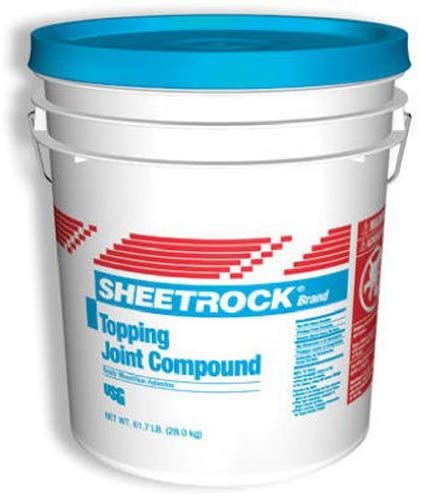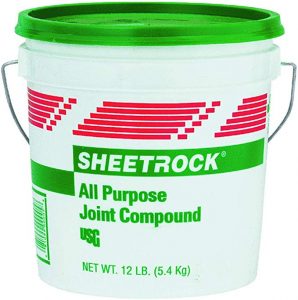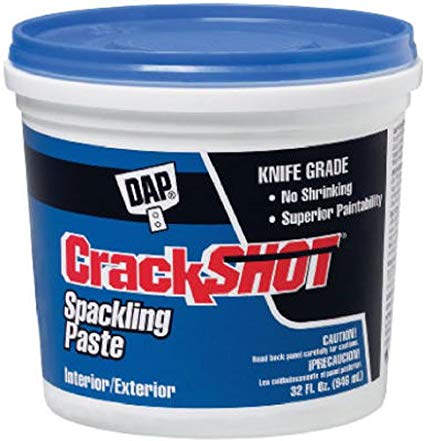Best Joint Compound
Best Joint Compound for... | Product Name | Learn More |
Best Overall Joint Compound | Dap 10102 Wallboard Joint Compound, 12-Pound | |
Best Joint Compound for Finishing | Sheetrock Topping Joint Compound | |
Best Joint Compound for Skim Coat | Sheetrock All Purpose Joint Compound | |
Best Joint Compound For Quick Repairs | 3M Patch Plus Primer | |
Best Joint Compound For Ceilings | DAP Crackshot Spackling Paste |
Our #1 pick for the best joint compound is Dap 10102 Wallboard Joint Compound, 12-Pound — Click to See the Price.
Table of Contents:
Best Joint Compound for Finishing
Best Joint Compound for Skim Coat
Best Joint Compound For Ceilings
…
Before starting any home project, finding the right materials is absolutely essential. If you plan to treat the walls in any shape or form, the best joint compounds will be high on the checklist.
Also known as drywall mud or compound mud, it is a product used when hanging drywall to fill in the joints while also securing drywall tape and covering the visible signs of nail heads and other small products. For home DIY enthusiasts and professional contractors alike, finding the best joint compounds is crucial.
Still a little confused? Keep reading for our shortlist of best products.
Best Joint Compound for Finishing
Sheetrock Topping Joint Compound – Click to See the Price
Topping joint compounds are all about creating a smooth finish and are used as the third and final layer once the drywall tape has already been adhered to the wall. Therefore, it needs to provide an unblemished result time and time again. The Sheetrock solution is a winner.
Topcoats applied with the Sheetrock topping joint compound will be far smoother than those used from other types of drywall mud while the layer can also be sanded down once it has dried. Manufactured in the United States, the product is also synonymous with painting supplies caulk and sealants.
The Sheetrock solution may require a little trial and error with adding water to get the right consistency as most applications will require a little thinning. Once this has been done, though, the applications can be very quick and simple, which is supported further by fast drying times and an air bubble-free solution even if you aren’t an expert.
While all topping joint compounds will need to be used in conjunction with other drywall mud solutions, it is unquestionably an important addition to the arsenal. Sheetrock’s premium quality product is the answer for casual and professional users.
Best Joint Compound for Skim Coat
Sheetrock All Purpose Joint Compound — Click to See the Price
Sheetrock manufactures a large range of drywall muds and building materials, and their all-purpose joint compound is another product that stands out as one of the best on the market. The ready mix can be used for painting, fill jobs, minor cracks, and repairs. It provides stunning outcomes in all situations.
The large one gallon bucket is particularly suitable for an all-purpose joint compound as you may go through large quantities due to its versatility. It’ll work very well for patching up small jobs while it is equally suited to full walls and bonding. It works with various drywall tape solutions, making it a great option when you plan to complete several jobs around the home.
As an all-purpose compound, it works well as an outside layer, even if it does require slightly more sanding than the dedicated topping joint compound. Nonetheless, the fact it can do this while also adhering the drywall tape is truly remarkable. With the ultra-reliable Sheetrock compound, which also boasts a longer life than many of the alternatives, you’ll be ready for any job.
The Sheetrock solution is also great for papier mache clay that can be used for a range of artistic crafts. Primarily, though, it is used for building works on walls as well as both internal and external corners.
Best Joint Compound For Quick Repairs: 3M Patch Plus Primer — Click to See the Price

When needing to make minor jobs to cover small amounts of drywall tape or other visible signs of the works you’ve completed, opting for the quick and easy solution is advised. 3M’s patch plus primer brings the benefits of a primer to spackling compounds for a two-in-one solution that only takes 30 minutes to set.
The 3M solution is the best of its kind, preventing flashing, shrinkage, or cracking. This makes it perfect for filling small holes and cracks in walls throughout the home or commercial building. It also covers nails and screws very well, keeping them in place at all times.
Given that you’ll be using the drywall compound for small jobs, the fast setting time is essential. You can have the wall prepped and painted with exceptional results in next to no time. Moreover, the durability of the compound and built-in primer ensures that the aesthetic appeal is built to last for a long time to come.
The 3M two-in-one compound isn’t designed purely with the small jobs in mind, but this is the situation where it thrives. It’s a quicker, cheaper, and more efficient option. Meanwhile, the easy application is ideal for home users.
Best Joint Compound For Ceilings
DAP Crackshot Spackling Paste — Click to See the Price
Walls aren’t the only feature that may require work. If you are planning to fill in ceiling holes or prepare it for decoration, DAP’s Crackshot spackling paste is the ideal compound mud. Available in half-pint, gallon, or quart size, you can easily find a solution that suits your needs – whether it’s treating one room or the entire property.
The white knife grade, smooth texture sands easily if you want to go the extra mile while it is also suited to a range of other internal and external tasks. It is ready to use and does not take long to dry. This means that you can prep and paint the ceilings in one day. Whether doing this alongside wall-related work or not, facilitating fast results is vital.
It does not require the use of primer and also provide no shrinkage or expansion attributes. Its easy application is supported by the fact that it stays in place, ensuring that the DAP material is one of the best on the market.
While DAP’s dry time indicator solution is another popular solution as it gives a visual notification as to when the ceiling is ready for painting, it’s not a necessary feature. Ultimately, if you’re just looking for a quality and smooth finish that will look great once painted, the spackling paste is ideal.
Even the perfect wall-filler isn’t necessarily going to cut it when it comes to filling holes in your ceiling. Aside from factors like moisture, construction materials and ease of access, you may want your newly-filled ceiling holes to dry out a tad quicker, to stop gravity taking its toll on your hard work.
So if you are planning to fill in holes up top or prepare the ceiling for decoration, DAP’s Crackshot spackling paste is the ideal compound mud for the job. Available in a number of different quantities including half-pint, gallon, or quart size, you can easily find the solution to fix the problem at hand.
The smooth, knife-grade texture gets into all the cracks and sands surfaces easily, for a beautiful, professional finish you can be proud of. It is suited to both internal and external tasks so you’ll use every last drop perfecting interiors and sealing outdoor structures alike.
But the major advantage of Crackshot spackling paste for solving your ceiling woes is that it is relatively quick to dry. This means that you can prep and paint the ceilings, all in one day. Whether doing this alongside wall-related work or not, facilitating fast results is vital.
It does not require the use of primer and also provides no shrinkage or expansion attributes. Its easy application is supported by the fact that it stays in place, ensuring that the DAP material is one of the best on the market.
While DAP’s dry time indicator solution is another popular solution as it gives a visual notification as to when the ceiling is ready for painting, it’s not a necessary feature. Ultimately, if you’re just looking for a quality and smooth finish that will look great once painted, the spackling paste is ideal.
Is there a difference between joint compound and drywall compound?
There isn’t a difference between joint compound and drywall compound. Both compounds are the same substance but have different names depending on where they are being applied. Joint and drywall compound compounds come in two forms, dry and wet. The benefits of dry joint compound mix is less weight to transport to the job site while the benefit of wet is rapid application and less mess.
Pros and Cons of Dry and Wet Joint Compound
Dry compound mix comes in large paper bags and is commonly used by contractor professionals because of its cheap cost, longer shelf life, and less waste. Some cons of dry joint compound are it is harder find at local shops and without the proper tools can be a.
Pre mixed, often called wet joint compound mix, is more beneficial for small quick jobs. Wet compound is often used by DIYers for home maintenance. A big con of wet compound is how quickly the compound can be used. This is due to the thickness and small volumes sold by retailers. Some other cons are it tends to spoil quickly and in some cases will develop mold, it will dry quicker once opened, and it’s very heavy.
Is spackle the same as joint compound?
The biggest difference between spackle and joint compound is that spackle doesn’t shrink as much. Because spackle doesn’t shrink, it is more ideal for everyday drywall repairs. Spackle comes in multiple thicknesses, thinner for small repair jobs like small nail holes or new cracks in drywall, and thicker grain spackle for fixing larger patches in drywall.
What is Joint Compound?
Commonly known as drywall mud or compound mud, joint compound is a a white powder material which is mixed with water, and then used for skim coating walls and ceilings. It is also used as an alternative to traditional plastering to finish joints, corner beads, trims, and fasteners. As well as this, it can be used when hanging drywall to fill in the joints while also securing drywall tape and covering the visible signs of nail heads and other small products and can help hide seams along walls leaving them ready for painting.
Jointing Compound is incredibly easy to apply and requires only a small amount of effort when you’re using drywall tape alongside it.
What is joint compound used for?
Joint Compound is most commonly used when hanging drywall for new or remodeled homes and can also be used to hide just about any type of seam along a wall or even corners where the walls meet. The application is super simple, and usually, you never more than just a few coats. Joint compound can get rid of almost all blemishes from the surface of drywall, including damage, fasteners, drywall tape, holes, bumps, tears, and other minor damage. It can also be used to finish gypsum panel joints, corner bead, trim, and fasteners, as well as skim coating.
What is the difference between spackle and joint compound?
Spackle and joint compound are two very similar products which have some overlap in their intended purpose, they are both used for repairing walls and in construction. They both look almost identical to the untrained eye, but they actually do have various formulations that affect factors when it comes to using them. For example the dry time, shrinkage are different and you need to choose the right one depending on the scope of a project you are doing. Spackle is generally used for an intended for repairing smaller damage to drywall or plaster. It is made of gypsum powder and binders, has a gooey toothpaste-like consistency, and is sold pre-mixed in small tubs. Spackle is used to fill small dings and dents, like nail holes, in walls, and it dries quicker with less shrinkage than joint compound. It’s fast dry time which is usually about 30 minutes, means you can sand and paint over the filled flaws almost straight away.
Joint compound, however, is most often used when new drywall is hung. It is also comprised mainly of gypsum dust that you mix yourself to a cake frosting-like consistency, or you can find it pre-mixed in a tub. The joint compound helps to create a smooth surface with undetectable seams, whereas Spackle, which is usually sold in smaller containers, isn’t suited for this purpose because it dries a lot quicker and gives you less time to work.
Joint compound can be used instead of spackle if necessary, but not vice versa. So if you have some joint compound left from another job, you can substitute it for spackle if you have a small wall repair that needs taking care of. However, as it shrinks, it does call for multiple coats, and needs a a longer dry time which can sometimes be up to 24 hours. Both products can dry out quickly during use as they’re exposed to air, so it is important to work as quickly as you can and to keep the product covered when not in use. If you’re mixing up your own joint compound with water, only make as much needed for the job at hand.
Can you skim coat with joint compound?
Yes, you can skim coat with joint compound, simply patch up any problems you have with setting-type joint compound, then let it compound harden (it doesn’t have to be dry), and then you can start skim coating.
Is joint compound the same as drywall mud?
Yes, they are the same. The main ingredient in joint compound and drywall mud is gypsum. They are both used for taping and finishing drywall seams, and you can also use them to patch holes, although using drywall mud or joint compound will take longer to dry and will shrink more than if you used spackling paste. But you can use mud or joint compound to fill any hole that you would normally fill with spackling paste.
How long is joint compound good for?
Most wet compounds are good for around nine months to a year as long as it is stored properly. Dry compounds have a similar shelf life which is about a year, so long as the proper storage methods are used, so make sure you read the labels to get the most out of them.
Can you add water to joint compound?
Yes, you can add water to a joint compound, but there is no specific amount as the style of texture of the joint compound will vary depending on what you want and what you are using it for. The joint compound comes as a thick paste in either a bucket or bagged in a box and is too thick to use for texturing as it is, so you will need to thin it with water. Mix it thoroughly to achieve the correct consistency as this will ensure easy application and an even texture coat and will make small renovation and repair projects simpler for you.
Can you reuse drywall mud?
You can reuse drywall joint compound again as long as you store it away properly. It’s important to scrape down the sides inside the bucket good and wipe the inside down with a damp cloth and then get all the compound to the bottom and level it out, then it will be good as new to use again when you need it.
Can you use moldy joint compound?
Mold spores will grow anywhere under proper conditions, for example, in continually moist conditions, so if you do find some mold, then it is best just to throw it away and buy some new joint compound.
Conclusion
The choice of joint compound spackling and mud is one that you need to get right. Whether opting for an all-in-one job or a combination of items for specific jobs, any of the above options will serve you well.



